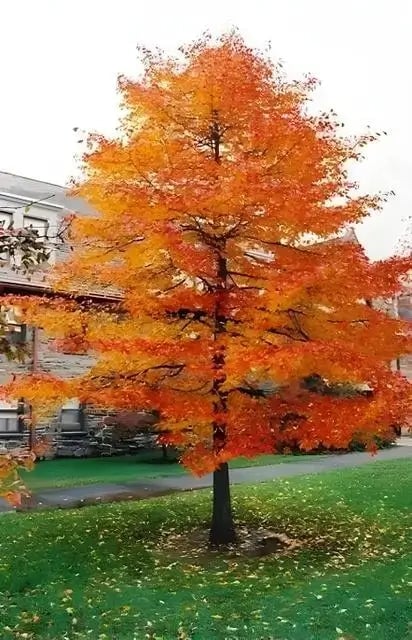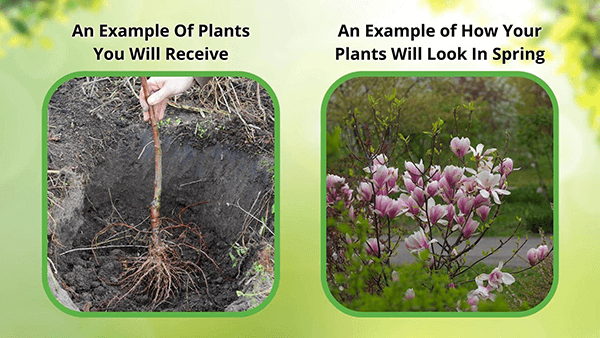




Tupelo Tree
Attracts birds and wildlife
Low maintenance requirements
Deep roots stabilize soil
Thrives in
ZONE 4ZONE 5ZONE 6ZONE 7ZONE 8ZONE 9This plant ships:
November 20251 Year Guarantee on all plants
Tupelo Tree - Nyssa sylvatica
The Tupelo Tree (Nyssa sylvatica) is an ornamental and deciduous tree that brings brilliant red and orange fall color to your yard, with a pyramidical habit.
Plant Details - Tupelo Tree
Family: Bignoniaceae
Light Requirement: Full Sun
Water Needs: Moist
Height: 30 – 50 ft.
Spread: 20 – 30 ft.
Growth Rate: Slow
Bloom Time: Spring
Flower Color: White
Wildlife Value: Attracts bees, birds
Landscape Uses and Maintenance - Tupelo Tree
Tupelo Tree is a deciduous tree that will make a great statement in your yard. This tree is dioecious, with both male and female flowers on separate trees, so make sure to get at least two trees to have the best fruit set. This tree is a slow grower, but it will be sure to last for a long time in your yard.
Plant this tree to create a shade garden, rain garden, or use as a focal point in your yard or landscape.
This tree will bloom from late spring through early summer. Its flowers are small and white, and the nectar will attract bees. The tree will produce small, dark blue fruits that are a great source of food for many birds and mammals.
Plant this tree in an area that gets full sun to partial shade. Avoid planting it in a location that has full shade as this will limit its growth.
It prefers well draining, acidic soil. These trees favor and tolerate wet soil very well and are often found in locations that are moist to wet in nature. If you have a wet location or rain garden in your yard, this tree is a great option to stabilize that area.
Watch this tree for signs of insect damage and treat accordingly.
This tree is deer resistant except when it is young.
Noteworthy Characteristics
Tupelo Tree is a great habitat for primary, and also secondary, cavity nesting birds, including owls, woodpeckers, and nuthatches.
As it is hard to find in stores, the honey that is made from the flowers of this tree is highly sought after and prized amongst those in the beekeeping community.
This Is How Your Plants Will Look upon Delivery

Height at Maturity
Over 25 Feet
Care
Tupelo tree thrives in full sun to partial shade with well-drained, acidic soil. Water regularly during establishment, then occasionally during dry periods. It’s low-maintenance and resistant to most pests. Prune in late winter if needed.
Plant Reproduction
Tupelo tree spreads through seed dispersal and root suckers.
Plant bare root trees during the dormant season in early spring or late fall (November through April). Dig the hole twice as wide as the roots so the soil is well-drained. Position the tree so the root flare is at or just above ground level. Fill the hole back with the soil you dug from and water. Maintain soil moisture, especially in the tree's early years, by providing deep, regular watering. Apply a 2-4 inch mulch away from the trunk at the base to retain moisture and suppress weeds. Prune trees during the first few seasons to establish strength and resilience, remove damaged branches, and continue maintenance pruning as the tree matures. Regularly inspect for pests and diseases and apply integrated pest management practices. Protect young trees from mechanical damage and extreme temperatures with tree guards, and stake them if necessary for support, removing the stakes after one or two years.
Shipping date depends on the date displayed and chosen when you order from the product's page.
We only accept returns on plants verified dead. If you think your plants have died, we offer a 1 year warranty, please use this File a Claim Link to verify dead plants and start with return warranty process.






.png?v=1722010105208&em-origin=cdn.accentuate.io&em-format=auto)
Attractive Appearance:
The tree is known for its lovely appearance, including distinctive alligator-like bark and beautiful fall colors. Its unique look makes it a standout feature in any garden.
Longevity:
Black Gum Trees can live for over 70 years with proper care, offering long-term beauty and value. This longevity allows you to enjoy its presence and create lasting family memories.
Versatile Growing Conditions:
It thrives in both wet and dry areas, making it adaptable to different garden environments. This versatility allows it to fit well into various landscaping conditions.
Rare Availability:
While not always easy to find in nurseries, the Black Gum Tree's unique beauty makes it a special and sought-after addition. If you find one, it's worth the effort to include it in your garden.
Caring Tips
How do I care for my Tupelo Tree?
Each box contains detailed care instructions and information about your product. But here's the basics.
Care Tips
Tupelo tree thrives in full sun to partial shade with well-drained, acidic soil. Water regularly during establishment, then occasionally during dry periods. It’s low-maintenance and resistant to most pests. Prune in late winter if needed.
Light Requirements
Tupelo tree flourishes in full sun to shade. It favors at least 4-6 hours of explicit sunlight daily but can tolerate light shade. Ideal for landscapes, it exhibits vibrant fall colors when grown in sunny locations.
Hardy Planting Zones
4 • 5 • 6 • 7 • 8 • 9
Header
Use this content to share information about your store and products.
Frequently Asked Questions
How often should I water my plants?
How do I know if my plant is getting too much or too little sunlight?
What should I do to prepare my plants for winter?
What are the signs that my plant needs fertilizing?
How can I prevent pests from damaging my plants?
How do I choose the right plant for my climate zone?






